Dr. Robert Coe (@ProfCoe) started his career as a high school mathematics teacher, before earning a PhD and becoming a Professor of Education and the Director of the Centre for Evaluation and Monitoring at Durham University, in Durham, England from 2010-2018. He currently holds the title of Director of Research and Development at Evidence-based Education (EBE; @EvidenceinEdu), a company whose mission is to “improve key educational outcomes” through evidence-based practice and professional development (EBE, 2020). Dr. Coe is also a Senior Associate for the Education Endowment Foundation (EEF; @EducEndowFoundn), a charitable organization dedicated to breaking the link between socio-economic status and academic achievement (EEF, 2020). As a result, and as the following analysis will reveal, Dr. Coe’s Twitter account provides an interesting blend of academic, business, and not-for-profit views of educational theories in action.
Educational research methodology is a recurrent theme from ProfCoe’s twitter activities as he is a strong advocate for evidence-based education and teachers’ training. However, while the catch phrase “evidence-based” typically carries authoritative power, ProfCoe’s tweets and re-tweets highlight the importance of basing our educational practice not only on evidence, but on high-quality evidence. For instance, one of his posts (Figure 1) directs the reader to a blog post by Robert Slavin, Director of the Center for Research and Reform in Education at John Hopkins University, that breaks down key factors to recognize strong and fair meta-analyses in educational settings (Slavin, 2020). Similarly, another tweet highlights a blog post by Thomas Martell, a science high school teacher with a passion for data, who argues that if a claim exists – realistic or not –, you can find evidence to support it (Figure 2) (Martell, 2020). He shares that, as part of an experiment in his class, it took at most 20 minutes for students to find support for even the wildest education claims. His take-home message is for internet-consuming educators to heighten their critical awareness of low-quality data by having an open-mind, by recognizing one’s own personal biases, by being cautious of single studies, and by looking for both confirmatory and contradictory evidence (Martell, 2020).
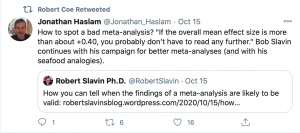
Figure 1. ProfCoe re-tweets a blogpost that encourages critical analysis of the meta-analysis within an educational context.
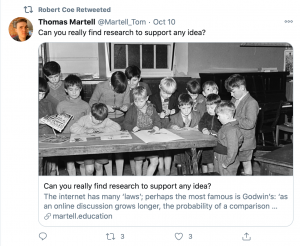
Figure 2. ProfCoe re-tweets a blogpost that shows that finding data is easy, but finding good quality data requires an open mind and an awareness of one’s own biases.
Expanding on this theme, ProfCoe’s tweet from October 11 (Figure 3) exemplified how adopting educational practices without empirical support may be detrimental. In this case, he shared a link that critiques the widespread support that coloured filters have gained to “help” people with dyslexia despite a lack of evidence supporting their effectiveness (Law, 2019). On one hand, rigorous double-blind studies and systematic reviews have found no significant effects of these filters on reading ability. On the other hand, 6 of out 8 UK dyslexia organization uncritically promote these products on their websites (Henderson et al, 2014; Law, 2019), thus leading to false hope and unnecessary expenses for patients with dyslexia. Taken together, ProfCoe’s twitter feed shows a sensitivity not only to use data to inform practice, but to critically reflect on the quality of the data on which we base our educational decisions.
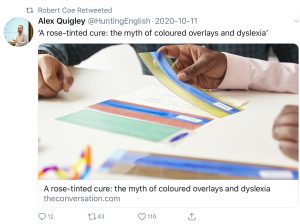
Figure 3. ProfCoe shares an example of how widespread educational practices without supporting evidence can cause more harm than benefits.
Another strong aspect of ProfCoe’s Twitter presence is to challenge accepted “truths” in education. Indeed, several tweets provide a different angle or diverging data on accepted practices in education. For instance, retrieval practice benefits from the support of several well-designed studies (Bjork et al, 2013; Hartwig & Dunlosky, 2012; Karpicke et al, 2009). Yet, ProfCoe challenges this conception (Figure 4) based, at least in part, on the fact that data from well-controlled experiments in a laboratory setting with relatively simple things to learn (e.g. list of words) cannot compare to the complexity of learning in a classroom where material may be more demanding, requires higher-order thinking, and is embedded in social and cultural contexts (Coe, 2020). He posts a similar critique of the well-loved knowledge organizer (Figure 5, Quigley, 2020).
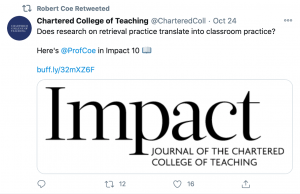
Figure 4. ProfCoe re-tweets one of his own article that challenges the efficacy of retrieval practice.
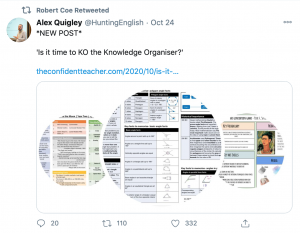
Figure 5. ProfCoe re-tweets a blog post that exposes the limitations of (and the alternatives to) the knowledge organizer.
Finally, ProfCoe shared a LA Times article that further exemplifies how he uses his Twitter voice to challenge the educational status quo with data (Figure 6). Written by Prof Daniel T. Willingham, from the department of psychology at the University of Victoria, the article capitalizes on data and offers suggestions on how to to enrich the “Zoom lectures” with social cues as a way to improve learning outcomes in online settings (Willingham, 2020). Willingham suggests that learning is optimal when it can rely on social cues. Through videoconferencing, most social cues are stripped away, which negatively affect learning. This is not too different from Taylor’s thesis (1996) who stated that social interactions, once border issues in higher education, became central concerns once the switch to online learning occurred. Willingham then proposes an innovative evidence-based solution: the presence of a facilitator, such as a parent, during online learning, to restore some of the sociality in the learning process. In summary, when ProfCoe tweets and re-tweets, he typically chooses blogposts and articles that share data that are a bit off the beaten path. In this regard, ProfCoe’s voice on Twitter nicely aligns with this course’s philosophy to critically appraise even the most popular educational theories and thoroughly examine whether other factors can be at play.

Figure 6. ProfCoe re-tweets a LA Times article that find evidence-based alternatives to the lack of sociality in online learning.
Interestingly, all but one tweets highlighted above share the common feature of directing the audience to a third party’s blog post. Importantly, the authors of these blogs are all respected educational practitioners, many of whom with advanced degrees. However, ProfCoe rarely directly shares peer-reviewed literature – a type of communication that would interest mostly academics – but focuses on the associated blog articles that describe, dissect, and disseminate the main findings of the original articles. This suggests a desire to make educational data and their implications available to a larger public. Given that the large majority of educators act in primary and secondary school settings and likely have limited experience with peer-reviewed literature, focusing on blog articles is an effective way to promote evidence-based practices in an audience-friendly way. Admittedly, this type of communication is limited in terms of nuances it can offer: good blog posts are condensed, entertaining, and informative – not comprehensive, detailed, and rigorous. However, this is a trade-off I suspect ProfCoe made very deliberately: let’s remember that ProfCoe now works for a company that promotes evidence-based education. Indeed, by far the single largest contributor to ProfCoe’s tweets is his company’s twitter account (@EvidenceInEdu) that directly promotes their activities (Appendix 1). Thus, reaching a larger group of educators via blog posts and accessible messages not only promotes his ideas, but also publicizes his business activities.
In conclusion, ProfCoe’s Twitter feed portrays educational theories as being dynamic entities that are susceptible to challenging views and diverging data. Applying McLuhan’s tetrad (1977) to Twitter, one could hypothesize that Twitter reverses the need for meaningful ideas as it is restricted to 140 characters. However, this limitation does not prevent ProfCoe to communicate complex ideas, integrate data, and discuss their implications and he does so by directing his audience to a number of external links. This process, however, introduces a third party in the communication: ProfCoe no longer communicates directly with his audience; rather, ProfCoe lends his platform to a number of different authors with whom – we assume – he shares similar viewpoints. This method of communication also enhances the authority of ProfCoe’s message. In fact, Olson (1980) mentioned that “criticism is least likely when ideas have both some validity and a transcendental source” (p. 194). While Olson refers to textbook in this case, ProfCoe’s ability to share his voice with other academic authors who discuss peer-reviewed evidence achieves both aspects: not one, but two “transcendental sources” convey a message anchored in data and validity.
References
Bjork, R. A., Dunlosky, J., & Kornell, N. (2013). Self-regulated learning: Beliefs, techniques, and illusions. Annual Review of Psychology, 64, 417-444.
Coe, R. (2020). Robert Coe Twitter. Retrieved from https://twitter.com/profcoe?lang=en on October 25, 2020.
Coe, R. Does research on retrieval practice translate into classroom practice? Retrieved from https://impact.chartered.college/article/does-research-retrieval-practice-translate-classroom-practice/ on October 29, 2020.
Evidence-based education (2020). Our values. Retrieved from https://evidencebased.education/our-values/ on October 25, 2020.
Educational Endowment Foundation (2020). About the EEF. Retrieved from https://educationendowmentfoundation.org.uk/about/ on October 25, 2020.
Hartwig, M. K., & Dunlosky, J. (2012). Study strategies of college students: Are self-testing and scheduling related to achievement? Psychonomic bulletin & review, 19(1), 126-134.
Henderson, L.M., Taylor, R.H., Barrett, B., Griffiths, P.G. (2014). Treating reading difficulties with colour. BMJ 349: g5160.
Karpicke, J. D., Butler, A. C., & Roediger III, H. L. (2009). Metacognitive strategies in student learning: do students practise retrieval when they study on their own? Memory, 17(4), 471-479.
Law, J. (2019). A rose-tinted cure: the myth of coloured overlays and dyslexia. Retrieved from https://theconversation.com/a-rose-tinted-cure-the-myth-of-coloured-overlays-and-dyslexia-120054 on October 29, 2020.
Martell, T. (2020). Can you really find research to support any idea? Retrieved form https://martell.education/2020/09/01/can-you-really-find-research-to-support-any-idea/ on October 29, 2020.
McLuhan, M. (1977). Laws of the media. ETC: A Review of General Semantics, 34(2), 173-179.
Olson, D. (1980). On the Language and Authority of Textbooks. Journal of Communication 30, 1, 186–196.
Quigley, A. (2020). Is it time to KO the knowledge organizer? Retrieved from https://www.theconfidentteacher.com/2020/10/is-it-time-to-ko-the-knowledge-organiser/ on October 29, 2020.
Slavin, R. (2020). How can you tell when the findings of a meta-analysis are likely to be valid? Retrieved from https://robertslavinsblog.wordpress.com/2020/10/15/how-can-you-tell-when-the-findings-of-a-meta-analysis-are-likely-to-be-valid/ on October 25, 2020.
Taylor, Peter G. (1996). Pedagogical challenges of open learning: Looking to borderline issues. In E. McWilliam & P.G. Taylor (eds) Pedagogy, Technology and the Body. New York: Peter Lang.
Willingham, D.T. (2020). Op-Ed: Why remote learning is hard – and how to make it easier. Retrieved from https://www.latimes.com/opinion/story/2020-09-18/remote-learning-hard-make-easier on October 30, 2020.
